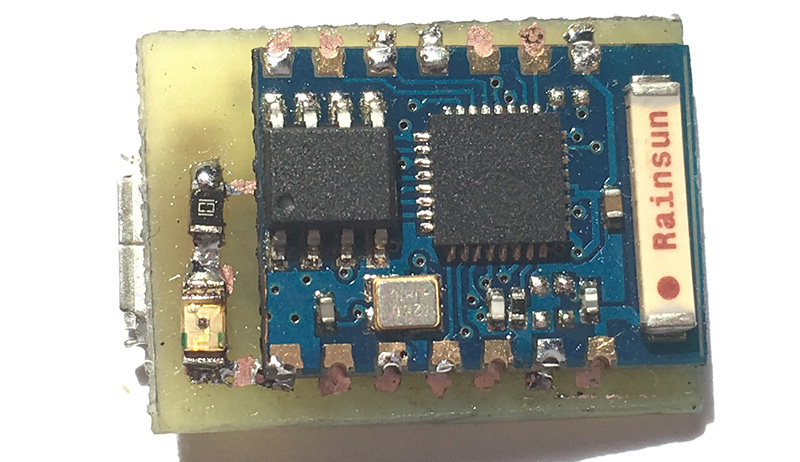Good grief, this smartphone-to-TV remote really drives home how simple hardware projects have become in the last decade. We’re talking about a voltage regulator, IR LED, and ESP8266 to add TV control on your home network. The hardware part of the hack is a homemade two sided board that mates an ESP with a micro-USB port, a voltage regulator to step down fom 5 to 3.3 v, and an IR LED for transmitting TV codes.
Let’s sit back and recount our good fortunes that make this possible. USB is a standard and now is found on the back of most televisions — power source solved. Cheap WiFi-enabled microcontroller — check. Ubiquitous smartphones and established protocols to communicate with other devices on the network — absolutely. It’s an incredible time to be a hacker.
Television infrared remote codes are fairly well documented and easy to sniff using tools like Arduino — in fact the ESP IR firmware for this is built on [Ken Shirriff’s] Arduino IR library. The rest of the sketch makes it a barebones device on the LAN, waiting for a connection that sends “tvon” or “tvoff”. In this case it’s a Raspberry Pi acting as the Homekit server, but any number of protocols could be used for the same (MQTT anyone?).
















Or just get a Samsung Galaxy S4 or another smartphone with IR capability, or even an old PalmOS PDA or some PocketPC PDA and IR remote software.
Having to plug hardware into the USB port is harking back to when there were IR blaster addon devices to attach to PalmOS PDAs that didn’t have built in IR, or whose IR transceivers couldn’t transmit in the CIR frequency range.
I should dig out my old Tungsten E2 and set it up just as a remote. Could also use it as a music player since all the Palm Powerups software is now freeware. Toss in an SDHC card and load it with MP3’s. It has WiFi, wonder if it can be made to connect and stream to my Samsung Smart TV? Someone would probably have to code up some WPA2 support for it. IIRC Palm *had* made WPA2 for the T|X, E2, LifeDrive and possibly some of their other later models but for some daft reason chose not to release it. What’s one more idiotic bad business decision atop the rest they made?
it’s Friday, don’t you have anything better to do?
Are there any PDAs that cost $5?
Yes, but what if you want to change channels on your home TV but you’re at work?
Your right. The cat keeps calling me to ask about changing the channel. I don’t know how it can figure out the smart phone I got it, but not the TV’s remote control.
What if the goal here was to make a pcb with esp chip and play with usb power? People here often forget that our projects are not about the end result but about building something with specific parts with a specific methodology just for the kick of it. Otherwise he would have simply used a remote control
this would be even better on some relative’s home network! TV on a midnight? no problem!
Or a friend’s house. TV not on at midnight? no problem!
Thanks for the reminder of the Galaxy ir built in. TV what’s that? I want to control the volume on my multi-channel audio amp.
Unfortunately Samsung removed the IR transmitter from the S5 and newer. :P
no, the S6 still has the ir transmitter only the S7 doesn’t have one…. and i miss it.
Nice to see someone using the ESP8266’s built-in IR remote peripheral!
I’ve tried the IR blaster on the LG G4, even though I could program it’s application directly from the remote it never seemed to be aimed in exactly the right direction. Blame the very small IR window, or the power, or the lighting in the room. But being able to park a device like that behind the sound bar, wired to an SBC media center so some commands go to TV/sound and others go to the media player? Seems perfect.
Drop that @”your neighbour” as kinda TVbGone…
];-)
StereobGone…
I have a few ESP-01s still kicking around. This looks like a good way to use up one or two in a useful project.
“It’s an incredible time to be a hacker”. I like that sentence.
Why not just use the TVs built in ethernet port and UDP control? If it’s a smart TV most of them support a smartphone app to control and the protocol for them is usually documented on the web already. I love this project but it seems to be a hardware solution to a software problem.